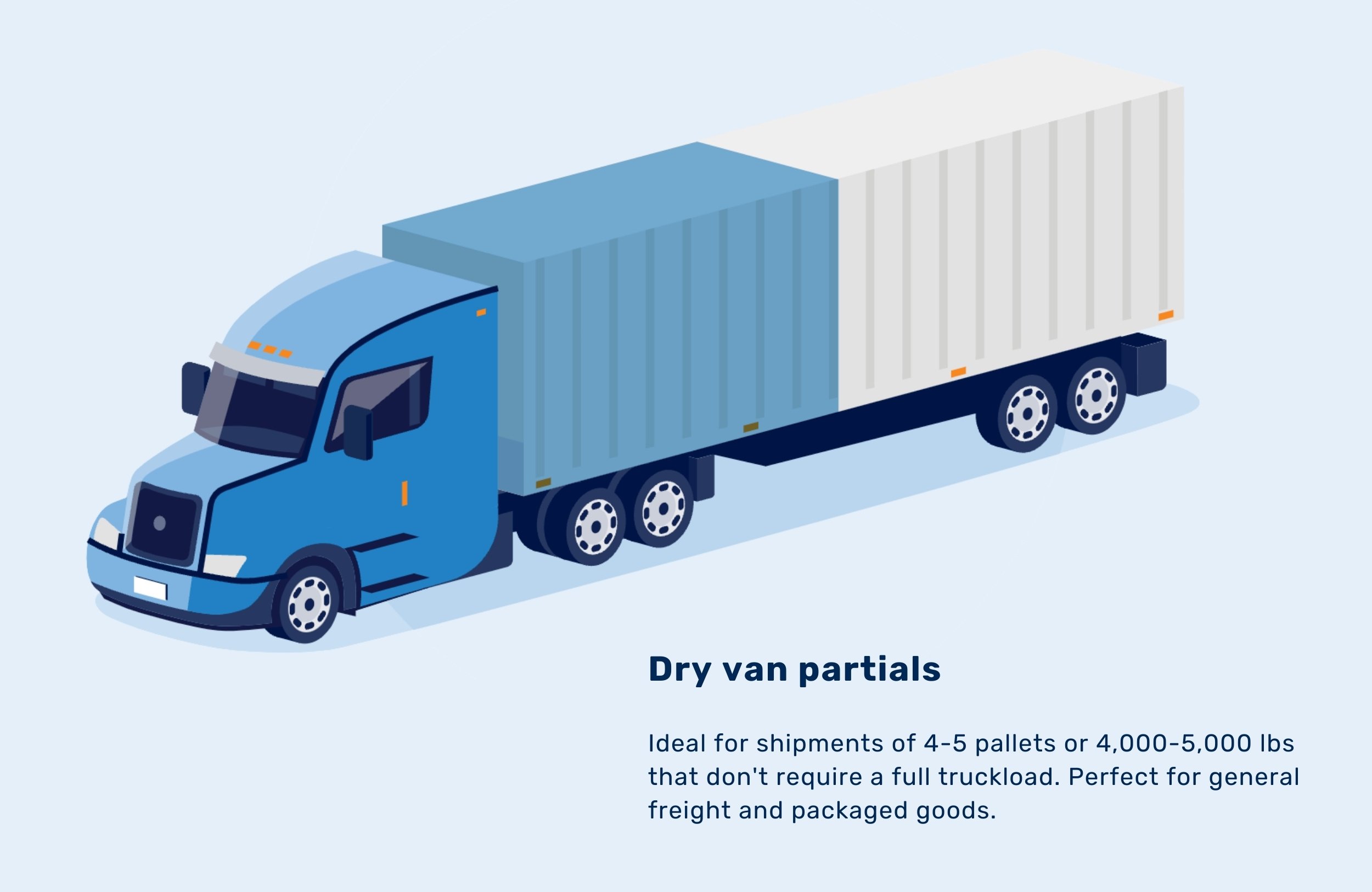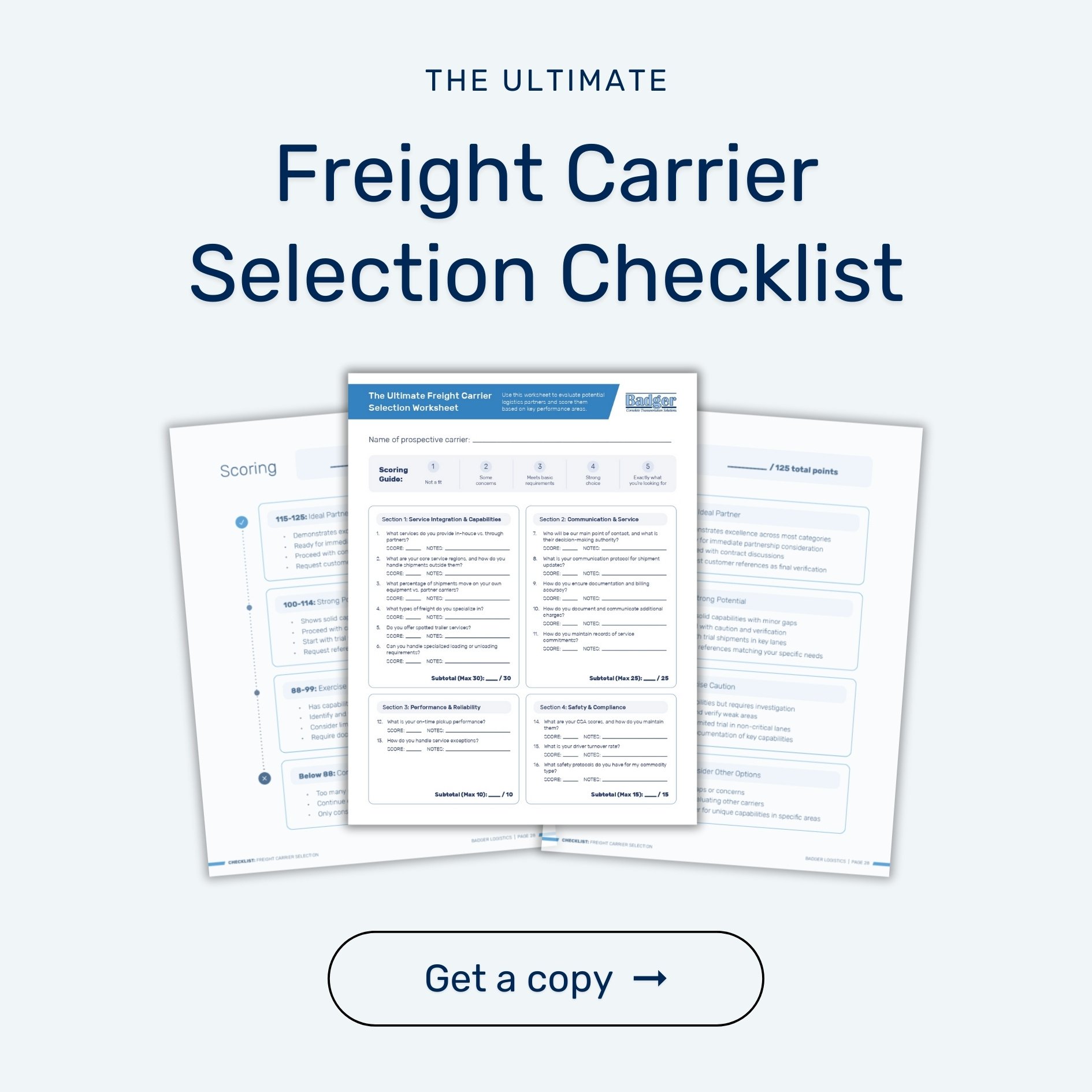Key takeaways
- Partial truckload (PTL) shipping is ideal for shipments weighing 5,000-38,000 pounds or 6-18 pallets that don't require a full trailer but are too large for traditional LTL.
- Major benefits include reduced handling (less damage), no freight classification requirements, more predictable transit times, and significant cost savings for mid-sized shipments.
- It's best suited for fragile items, time-sensitive deliveries that aren't urgent enough for expedited shipping, low-density items, and businesses currently shipping multiple LTL loads to the same destination.
- How it works: Your shipment stays on one truck from pickup to delivery (unlike LTL's hub-and-spoke model), sharing trailer space with just a few other shipments headed in the same direction, resulting in fewer touchpoints and faster delivery.
Badger Logistics delivers expert partial shipping services for reliable and efficient transportation of your mid-sized freight. Learn more about our partial freight services and get a competitive rate quote to join hundreds of shippers discovering a better alternative to traditional LTL.
Every day, I see businesses forcing their shipments into either LTL or full truckload categories when there's a better option staring them right in the face. I can tell you with certainty that partial truckload shipping is the most underutilized, misunderstood, and potentially valuable shipping method for mid-sized freight.
If you're regularly shipping between 5,000 and 38,000 pounds or 6-18 pallets, you're likely overpaying. You're either using LTL and getting hammered with freight class charges and excessive handling, or you're paying for an entire truck you're not fully utilizing.
Here's the truth: Partial truckload shipping combines the best aspects of both LTL and full truckload while eliminating many of their drawbacks. Your freight stays on one truck, you don't deal with freight classes, you get faster transit times than LTL, and you only pay for the space you actually use.
In this guide, I'll break down everything you need to know about partial truckload shipping with straightforward facts based on what I've learned helping hundreds of shippers optimize their logistics.
What is partial truckload shipping?
Partial truckload (PTL) shipping is the underutilized middle child of the freight world, sitting right between less than truckload (LTL) and full truckload (FTL) shipping. Despite being incredibly valuable to the right shipper, it's often overlooked because many shippers simply don't know it exists.
In my 15+ years in the logistics industry, I've seen countless businesses overpaying by forcing their shipments into either the LTL or FTL category when partial truckload would have been the perfect fit.
Partial truckload shipping is exactly what it sounds like—you're shipping a partial load that doesn't fill an entire trailer but is too large for traditional LTL shipping.
Typically, partial truckload shipments:
|
Some carriers might refer to partial truckload as "volume LTL," but there are significant differences that make partial truckload a distinct and advantageous shipping method for many businesses.


Partial truckload vs. LTL vs. Full Truckload
To understand where partial truckload fits in the logistics ecosystem, it helps to compare it to its more well-known siblings: LTL and full truckload shipping. We broke these three shipping models down in much more detail in our other guide.
| Feature | Partial Truckload (PTL) | Less Than Truckload (LTL) | Full Truckload (FTL) |
|---|---|---|---|
| Typical Weight | 5,000-38,000 lbs | Under 5,000 lbs | Over 38,000 lbs |
| Typical Size | 6-18 pallets | 1-5 pallets | 20+ pallets |
| Freight Class Required | No | Yes | No |
| Number of Stops | Few | Multiple | Direct |
| Handling | Minimal | Multiple touchpoints | Minimal |
| Transit Time | Medium | Longest | Fastest |
| Pricing Structure | Based on space used | Based on freight class, weight, and dimension | Flat rate regardless of load size |
| Best For | Mid-sized shipments, fragile goods | Small shipments | Large shipments, time-sensitive freight |
In short, partial truckload shipping combines some of the best aspects of both LTL and FTL while eliminating some of their downsides.
The advantages of partial truckload shipping
After helping hundreds of businesses optimize their shipping strategies, I've identified several standout benefits that make partial truckload shipping the perfect solution for many situations:
Reduced handling = less damage
One of the biggest advantages of partial truckload shipping is the reduced handling. Unlike LTL, which follows a hub-and-spoke model where your freight might be loaded and unloaded multiple times as it changes trucks, partial shipments typically stay on the same truck from origin to destination.
This dramatically reduces the chances of damage. I've seen countless situations where fragile merchandise arrived damaged via LTL due to excessive handling, but arrived perfectly intact when switched to partial truckload shipping.
No freight classification required
If you've ever dealt with LTL shipping, you know the headache of freight classification. Get it wrong, and you face reclassification charges that can significantly increase your costs.
With partial truckload, you don't need to worry about freight class at all. You simply provide the dimensions, weight, and number of pallets, and you're good to go. This eliminates the risk of unexpected reclassification fees and simplifies the shipping process.
More predictable transit times
Because partial truckload shipments typically involve fewer stops and less handling than LTL, transit times are often more predictable. This is crucial if you're shipping time-sensitive goods or need to maintain tight inventory control.
I've worked with many manufacturing clients who switched from LTL to partial truckload specifically because they needed more reliable delivery timeframes to support their just-in-time inventory systems.
Cost savings
For shipments that fall into the "partial" sweet spot, the cost savings can be substantial. You're only paying for the trailer space you need, unlike full truckload, where you pay for the entire trailer regardless of how much you fill it.
At the same time, you're avoiding the premium per-pound rates that come with LTL shipping for larger shipments. It's truly the best of both worlds for mid-sized shipments.
Environmentally friendly
By consolidating partial shipments, carriers can optimize their trailer space, which means fewer trucks on the road and reduced emissions. If sustainability is important to your brand, partial truckload shipping is a greener option than shipping via full truckload when you don't need the entire trailer.
When to choose partial truckload shipping
Based on my experience helping businesses optimize their shipping strategies, here are the scenarios where partial truckload shipping makes the most sense:
|
Your shipment falls in the "sweet spot"
|
|
You're shipping fragile items If your products are susceptible to damage, the reduced handling of partial truckload shipping can be a lifesaver. I've worked with clients in industries ranging from glass manufacturing to electronics who've seen dramatic reductions in damage claims after switching to partial truckload shipping. |
|
You have time-sensitive (but not urgent) deliveries If your shipment isn't quite urgent enough to justify expedited shipping but still needs to arrive within a reasonable timeframe, partial truckload offers a good balance of speed and cost-effectiveness. You'll get faster transit times than LTL without paying premium expedited rates. |
|
You're shipping low-density items Low-density items (large but lightweight) can be extremely costly to ship via LTL because they take up valuable trailer space relative to their weight. LTL carriers typically charge based on dimensional weight for these items, which can result in much higher costs. Partial truckload pricing is often more favorable for low-density shipments. |
|
You currently ship multiple LTL loads to the same destination If you're regularly sending multiple LTL shipments to the same destination, consolidating them into a single partial truckload shipment could yield significant cost savings while also reducing the carbon footprint of your shipping operations. |
How partial truckload shipping works
Understanding the mechanics of partial truckload shipping can help you determine if it's the right choice for your business. Here's a simplified overview of how the process typically works:
1. Request a quote from a logistics partner
The first step is to request a quote from a broker or carrier that offers partial truckload services. You'll need to provide:
|
At Badger Logistics, we collect this information upfront to ensure we match your shipment with the right carrier and equipment. Contact us or get a quote now.
2. Carrier selection
Once you've accepted a quote, the broker or carrier will find the right truck for your shipment. This is typically a standard 53-foot dry van trailer, though other equipment types may be used depending on your specific needs.
Unlike dedicated full truckload, your freight will share the trailer with shipments from other customers, but it won't be handled multiple times like LTL freight.
3. Pickup
The carrier will arrive at your location to pick up your freight within the agreed-upon timeframe. Your pallets will be loaded onto the trailer alongside other partial shipments heading in the same general direction.
This is a key difference from LTL: with partial truckload, the driver typically picks up fewer shipments (often just 2-4) before heading toward the destination.
4. Transit
Your freight remains on the same truck throughout transit. The carrier might make a few stops to pick up or deliver other partial shipments, but there's no transferring of your freight between multiple trucks or terminals as there would be with LTL. This results in shorter transit times and less handling of your goods.
5. Delivery
The carrier delivers your freight to its destination. Because partial truckload shipments involve fewer stops than LTL, delivery timeframes are often more predictable.
Common types of freight perfect for partial
Through my years in the industry, I've noticed certain types of freight consistently benefit from partial truckload shipping:
|
Trade show equipment and displays |
Trade show displays are often too large for economical LTL shipping but don't require a full truck. They're also frequently fragile and expensive, making the reduced handling of partial truckload shipping extremely valuable. |
| Store fixtures and retail displays | Similar to trade show equipment, retail fixtures often occupy that middle ground between LTL and full truckload. They're also susceptible to damage, making partial truckload's reduced handling a significant advantage. |
| Machinery and equipment parts | Mid-sized machinery or equipment components often benefit from partial truckload shipping. These items are typically high-value and may have irregular dimensions that make LTL shipping challenging or expensive. |
| Furniture | Furniture is notoriously difficult to ship via LTL due to its size, shape, and susceptibility to damage. Partial truckload shipping offers a more cost-effective alternative to full truckload for businesses that don't need an entire trailer. |
| Building materials | Materials like flooring, cabinetry, windows, and doors often fit perfectly into the partial truckload category. They're too large for efficient LTL shipping but rarely require a full trailer. |
| Food and beverage products | Non-perishable food and beverage products often ship well via partial truckload, especially when moving from distribution centers to retail locations. |
| Automotive parts | Mid-sized automotive parts shipments, particularly those going from suppliers to manufacturing facilities, often fall into the partial truckload sweet spot. |
Pricing factors for partial truckload shipping
Understanding how partial truckload shipping is priced can help you better compare it to other shipping options.
Several factors influence partial truckload rates:
|
How to prepare a partial shipment
Proper preparation of your partial truckload shipment ensures smooth transit and minimizes the risk of damage or delays.
1. Palletize properly
- Use quality pallets in good condition (preferably Grade A 48" x 40" standard pallets).
- Don't allow freight to overhang the pallet edges.
- Stack heavier items at the bottom.
- Limit pallet height to 7 feet for standard trailers.
- Secure items to the pallet using stretch wrap, strapping, or both.
2. Label things clearly
- Each pallet should have clear shipping labels.
- Include destination, piece count, and any special handling instructions.
- For multi-pallet shipments, mark each pallet (e.g., "1 of 5", "2 of 5").
- Add "FRAGILE" labels if applicable.
3. Provide accurate information
- Ensure the dimensions and weight you provide are accurate.
- List any special handling requirements upfront.
- Specify if a liftgate is needed at pickup or delivery.
- Note any delivery appointment requirements.
4. Prepare your documentation
- Bill of lading with accurate piece count and weight.
- Commercial invoice for high-value items.
- Any specific documentation required for your industry.
5. Consider Freight Insurance
For valuable shipments, consider purchasing additional freight insurance. While carrier liability does provide some protection, it's often limited and may not cover the full value of your goods.
|
💡 Protip: Identify consistent, regular shipments ("anchor shipments") along busy lanes. These can help your logistics partner consolidate loads more efficiently, significantly improving your pricing and transit predictability. A few other tips:
|
Common PTL pitfalls (and how to avoid them)Partial truckload shipping offers significant benefits, but to fully realize these advantages, it’s crucial to avoid common pitfalls. Here are a few common mistakes shippers make and tips on how you can prevent them:
|
Key metrics and performance Indicators
When evaluating your partial truckload shipping performance, focus on these key metrics:
|
Finding the right partial truckload provider
Not all carriers or brokers handle partial truckload shipments, and even fewer specialize in them. Here's what to look for when selecting a partial truckload provider:
Experience with partials
Look for providers with specific experience handling partial truckload shipments, not just those who offer it as an afterthought to their LTL or full truckload services.
Network and coverage
Ensure the provider has good coverage in your shipping lanes. A strong network means better access to capacity and more competitive rates.
Technology and visibility
In 2025, real-time tracking and digital documentation should be standard offerings. Look for providers with robust technology platforms that give you visibility into your shipments throughout transit.
Customer service
Responsive customer service is crucial, especially when issues arise. Test responsiveness during the quote process—it's often indicative of the service level you'll receive as a customer.
Reputation and reviews
Research potential providers online and ask for references. Look for customers in similar industries or with similar shipping needs.
Financial stability
In today's volatile logistics market, the financial stability of your shipping partners matters. Well-established companies with solid financial footing are less likely to suddenly go out of business or cut corners on service.
| At Badger Logistics, we specialize in partial truckload shipping with a focus on providing transparent pricing, excellent customer service, and reliable performance. Our team has decades of combined experience in handling partial shipments for businesses across various industries. |
FAQs about partial truckload shipping
Over the years, I've been asked countless questions about partial truckload shipping. Here are answers to some of the most common:
-
How is pricing determined for partial truckload shipping? Partial truckload pricing is primarily based on the amount of trailer space your shipment occupies, typically measured in linear feet or pallet positions. Weight, distance, and market conditions also play significant roles in determining rates.
-
What's the difference between partial and LTL shipping? While both involve sharing trailer space with other shipments, partial truckload freight typically stays on one truck from origin to destination. LTL freight, by contrast, often moves through a hub-and-spoke system with multiple handling points. Partial truckload also doesn't require freight classification and generally has faster transit times than LTL for comparable distances. We wrote much more about this in our other guide.
-
Is partial truckload shipping faster than LTL? Yes, in most cases. Because partial shipments involve fewer stops and less handling than LTL, they typically arrive faster. The difference is most noticeable for long-distance shipments, where LTL might involve transfers between multiple regional carriers.
-
How far in advance should I book a partial truckload shipment? For standard lanes, 2-3 business days is usually sufficient. For remote locations or during peak shipping seasons, 4-5 business days is recommended. That said, at Badger Logistics, we pride ourselves on our ability to accommodate last-minute shipping needs whenever possible.
-
Can I track my partial truckload shipment? Yes, most reputable partial truckload providers offer real-time tracking through online portals or mobile apps. At Badger Logistics, we provide comprehensive tracking information and proactive status updates.
-
Is insurance included in partial truckload shipping? Carriers provide basic liability coverage, but it's often limited to a specific amount per pound. For valuable shipments, we recommend purchasing additional freight insurance to ensure full protection.
-
What happens if my shipment is larger than originally quoted? If your shipment exceeds the dimensions or weight you provided in your quote, you'll likely incur additional charges. It's essential to provide accurate information upfront to avoid surprises on your invoice.
-
Can I use partial truckload for international shipping? Partial truckload is primarily a domestic shipping solution, though it can be used for shipments to and from Canada and Mexico. For overseas shipping, other modes like ocean freight consolidation would be more appropriate.
-
How do I know if partial truckload is right for my business? Consider your typical shipment size, value, fragility, and time sensitivity. If you're regularly shipping between 5,000 and 38,000 pounds, occupying 6-18 pallet spaces, or if damage reduction is a priority, partial truckload might be ideal. Contact us for a consultation, and we can help you determine the most cost-effective shipping solution for your specific needs.
Get a competitive rate quote for your partial truckload shipment
At Badger Logistics, we specialize in helping shippers identify the optimal shipping mode for each situation. Our extensive partial truckload capabilities — backed by strong carrier relationships, comprehensive service options, and transportation expertise — provide you with reliable, cost-effective solutions for your mid-sized shipments.
Whether you're looking to solve specific shipping challenges, optimize your transportation budget, or simply explore your options, our team is ready to help. Contact us today to discuss how partial truckload shipping can benefit your supply chain.





